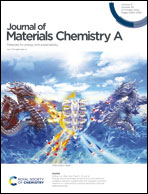High-loading Fe1 sites on vanadium disulfides: a scalable and non-defect-stabilized single atom catalyst for electrochemical nitrogen reduction†
Abstract
The development of single-atom-catalysts (SACs) has been an important goal in catalysis research over the last years. Despite great efforts devoted to new synthetic methods for producing atomically dispersed metal atoms, the practical application of single-atom-catalysts still suffers from very low loading of metal atoms, poor selectivity of atomic dispersion and the instability of single atoms on the surface. Here, we show that atomically dispersed Fe atoms on non-defective VS2 are stable at temperatures well above room temperature and remain generally mono-dispersed due to strong Fe–Fe repulsion and high diffusion barriers. Theoretically, the coverage of Fe1 sites may exceed 11.1%. Subsequently, we demonstrate catalytic activity of this Fe1/VS2 catalyst with the electrochemical N2 reduction reaction (NRR). Our calculations show that the Fe1/VS2 catalyst exhibits outstanding catalytic activity for N2 fixation at room temperature through a hybrid mechanism, with a low overpotential of 0.35 V. This work should provide some insights and guidance for the design of scalable single metal catalysts on non-defective supports in the future.



 Please wait while we load your content...
Please wait while we load your content...